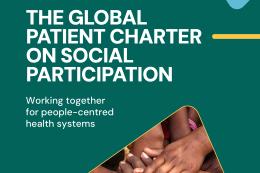“Tackling Antimicrobial Resistance Together”: The time to act is now

To mark World Antimicrobial Awareness Week (WAAW) the International Alliance of Patients’ Organizations (IAPO), the IAPO Patients for Patient Safety Observatory and its AMR Patient Alliance, the International Federation of Pharmaceutical Manufacturers and Associations (IFPMA) and the World Medical Association (WMA) call for cross-sectoral collaboration to address the growing threat of AMR. AMR is estimated to have been directly responsible for ca. 1.3 million deaths globally in 2019, and overall associated with ca. 5 million deaths . Left alone, AMR could reduce global GDP annually by USD 3.4 trillion and push 24 million more people into extreme poverty in the next decade . In 2019, WHO also included AMR in its list of ten threats to global health, citing the potential for widespread consequences in modern medicine if the world runs out of effective antibiotics . AMR is a complex issue spanning the One Health spectrum and as such, requires concerted efforts from the human health, animal and agricultural sector and the environment to effectively achieve progress.
Global leaders have long recognized the urgent need for action, including at the first ever United Nations General Assembly (UNGA) high-level meeting (HLM) on AMR in 2016. In the years since, AMR was featured under virtually every G7 and G20 presidency. The 2016 HLM catalyzed broad action, resulting in the establishment of several new key initiatives. It also spurred action in individual countries towards developing and implementing National Action Plans on AMR. Since then, the COVID-19 pandemic has further shown us the impact infectious disease can have and has demonstrated the importance of preparedness. AMR, if unchecked, has the potential to be even worse.
Next year the attention of global leaders will once again turn to AMR during the 2024 UNGA HLM on AMR. By then, we all need to take a closer look at the achievements and revisit approaches to craft bolder action in tackling this global public threat. While the world is now sensitized to the threat AMR poses, important gaps in action remain. Next year’s HLM is a good milestone providing a unique opportunity to establish meaningful commitments and targets that can holistically address AMR before the time runs out. And, we need to ensure to stay on the path of those commitments and targets.
We call on member states to ensure the following critical points are emphasized in the 2024 AMR high level political declaration and subsequent funding and implementation:
Appropriate Use & Surveillance
The education of the public as well as healthcare professionals is paramount to improve antimicrobial prescribing and dispending. Shared decision making with informed patients will help prescribers to ensure antibiotics are only given when needed. Member states are called upon to establish national guidelines aligning with the WHO AWaRe guidance and to ensure that diagnostics are prioritized and made widely available to prescribers so that the effectiveness of new and old antibiotics is preserved, for as long as possible for as many patients as possible. Where not possible, governments are encouraged to adopt and promote the use of pathogen-directed therapeutic guidance based on evidence from clinical guidelines. Reinforcing the commitments to achieve targets of the Global AMR Action Plan, the National Action Plans and the AWaRe is critical and should be coupled with intersectoral accountability and fast-paced actions. The establishment of national comprehensive surveillance systems will allow for accurate characterization of resistance patterns globally. Sharing resistance data through international networks such as GLASS will allow for a better coordinated global effort to curb AMR.
Prevention
A focus on funding large scale Water, Sanitation and Hygiene (WASH) programming in the community, and Infection Prevention and Control at the Healthcare facility level is urgent and should be at the core of the measures to curb AMR. While some progress has been made, additional support to member states to implement the monitoring targets of the Global Strategy on Infection Prevention and Control is crucial.
Vaccines are a powerful tool to reduce drug-resistant infections globally and help preserve the effectiveness of antibiotics. Additional funding and expansion of existing immunization programs with a focus on equity will allow for furthering the role of vaccines towards reducing the spread of AMR.
Innovation
New AMR-relevant technologies are urgently needed to stop the threat of resistance. Leading countries globally need to implement impactful new incentives that reward the development of new antibiotics commensurate with their value. To support this implementation, global coordination between all stakeholders is needed to develop robust yet agile set of treatment needs and targets that include emergent resistant threats. Clinical trials for new antibiotics should also strive to embed principles that allow for greater patient centricity and inclusivity of under-served populations. Enhancing meaningful representation of patients and diverse participants in clinical trials including at the design stage helps provide information and results that are representative and generalizable. In addition, providing information and awareness raising of the complexity of development of new antibiotics is critical to ensure ownership and sense of responsibility for preserving the effectiveness of the new medicines.
Access
Ensuring access to new technologies for preventing AMR, especially diagnostics and to support pathogen-directed therapeutic guidance based on clinical evidence is of prime importance, since the greatest unmet need remains in Low and Low Middle-Income Countries. Collectively we need to explore new procurement models that can address gaps in global access and all countries need to address access barriers within their systems as appropriate, including advancing expedited regulatory pathways, facilitating market entry, and reforming HTA/reimbursement practices.
Environmental impact
Proper disposal of antibiotics at the individual or manufacturing level is of paramount importance. Education of the public on their role both in human and veterinary medicine as well as in agriculture should be emphasized. We also call on member states to support manufacturers of antibiotics which participate in tendering or secure reimbursement by encouraging them towards the adoption of the British Standards Institution or similar certification of the Antibiotic Manufacturing Standard.
----
[1] https://www.thelancet.com/journals/lancet/article/PIIS0140-6736(21)02724-0/fulltext
[1] https://www.unep.org/resources/superbugs/environmental-action
[1] https://www.who.int/news-room/spotlight/ten-threats-to-global-health-in-2019



